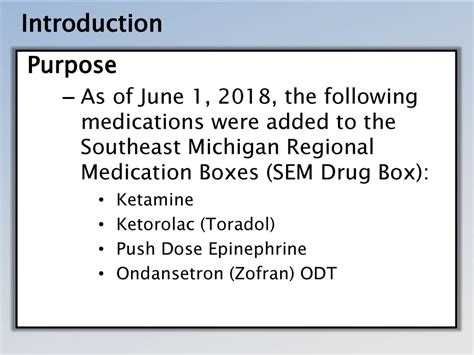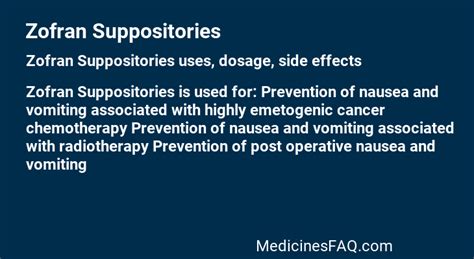Intro
The medication Zofran, also known by its generic name ondansetron, has been a crucial component in the management of nausea and vomiting, particularly in patients undergoing chemotherapy, radiation therapy, and surgery. Understanding the importance of this medication is vital for patients and healthcare providers alike, as it significantly impacts the quality of life for those undergoing treatments that often induce severe nausea and vomiting. The development of Zofran marked a significant advancement in the field of antiemetic therapy, offering a more effective and safer alternative to older medications.
The introduction of Zofran into clinical practice has revolutionized the way nausea and vomiting are managed in various medical settings. Its effectiveness in preventing and treating these symptoms has improved patient outcomes, reduced the risk of dehydration and electrolyte imbalances, and enhanced overall patient comfort and satisfaction. Moreover, Zofran's mechanism of action, which involves blocking the action of serotonin, a natural substance that may cause nausea and vomiting, has been a subject of interest for researchers seeking to understand the complex pathways involved in the emetic response.
As the medical community continues to evolve, with new treatments and therapies being developed, the role of Zofran remains pivotal. Its application extends beyond the management of chemotherapy-induced nausea and vomiting to include the prevention of postoperative nausea and vomiting, and the treatment of gastroenteritis-induced emesis. The versatility and efficacy of Zofran have made it a staple in many healthcare settings, with its benefits being recognized by patients and healthcare providers worldwide. The importance of understanding how Zofran works, its benefits, potential side effects, and its proper use cannot be overstated, as this knowledge empowers patients to make informed decisions about their care and improves adherence to treatment regimens.
Introduction to Zofran

Zofran, or ondansetron, is classified as a serotonin 5-HT3 receptor antagonist. It works by blocking the action of serotonin, a natural substance that may cause nausea and vomiting. This mechanism of action is particularly effective in preventing nausea and vomiting caused by cancer chemotherapy, radiation therapy, and surgery. The drug is available in various forms, including tablets, orally disintegrating tablets, and solution for injection, making it versatile for different patient needs and preferences.
How Zofran Works
The mechanism by which Zofran exerts its antiemetic effects is through the selective inhibition of the 5-HT3 receptors found in the vagal nerve terminals and the chemoreceptor trigger zone in the central nervous system. By blocking these receptors, Zofran prevents the initiation of the vomiting reflex, thereby reducing the incidence of nausea and vomiting. This targeted action contributes to its efficacy and safety profile, as it minimizes the risk of affecting other neurotransmitter systems.Benefits of Zofran

The benefits of Zofran are multifaceted, contributing significantly to patient care and outcomes. Some of the key benefits include:
- Effective Prevention and Treatment of Nausea and Vomiting: Zofran is highly effective in preventing and treating nausea and vomiting induced by chemotherapy, radiation therapy, and surgery.
- Improved Quality of Life: By reducing the incidence of nausea and vomiting, Zofran improves patients' quality of life, enabling them to maintain their nutritional status, hydration, and overall well-being.
- Reduced Risk of Dehydration and Electrolyte Imbalances: Effective management of nausea and vomiting reduces the risk of dehydration and electrolyte imbalances, which are common complications in patients experiencing persistent vomiting.
- Convenience and Versatility: Available in various formulations, Zofran offers flexibility in administration, catering to different patient needs and preferences.
Side Effects and Precautions
While Zofran is generally well-tolerated, it can cause side effects, some of which may be serious. Common side effects include headache, dizziness, constipation, and diarrhea. Serious side effects, although rare, can include allergic reactions, serotonin syndrome, and changes in heart rhythm. It is essential for patients to discuss their medical history, including any heart conditions, and all medications they are taking with their healthcare provider before starting Zofran.Uses of Zofran

The applications of Zofran are diverse, reflecting its efficacy in managing nausea and vomiting across various clinical scenarios:
- Chemotherapy-Induced Nausea and Vomiting (CINV): Zofran is a cornerstone in the prevention and treatment of CINV, significantly reducing the distress associated with chemotherapy.
- Radiation-Induced Nausea and Vomiting: It is also used to prevent nausea and vomiting caused by radiation therapy, improving the tolerability of this treatment modality.
- Postoperative Nausea and Vomiting (PONV): Zofran is effective in preventing PONV, reducing the risk of complications and improving patient recovery post-surgery.
- Gastroenteritis-Induced Emesis: In some cases, Zofran may be used off-label to treat nausea and vomiting associated with gastroenteritis, although its use in this context should be guided by clinical judgment and patient-specific factors.
Dosage and Administration
The dosage of Zofran varies depending on the indication, patient age, and renal function. For chemotherapy-induced nausea and vomiting, the typical dose is 8 mg administered 30 minutes before chemotherapy, followed by 8 mg every 8 hours for up to 2 days after chemotherapy. For radiation therapy, the dose is usually 8 mg three times a day. In the prevention of postoperative nausea and vomiting, a single dose of 16 mg is given one hour before surgery. It is crucial to follow the specific dosing instructions provided by the healthcare provider, as the regimen may be tailored to the individual patient's needs.FAQs About Zofran

What is Zofran used for?
+Zofran, or ondansetron, is used to prevent nausea and vomiting caused by cancer chemotherapy, radiation therapy, and surgery.
How does Zofran work?
+Zofran works by blocking the action of serotonin, a natural substance that may cause nausea and vomiting, at the 5-HT3 receptors.
What are the side effects of Zofran?
+Common side effects of Zofran include headache, dizziness, constipation, and diarrhea. Serious side effects, although rare, can include allergic reactions and changes in heart rhythm.
As patients and healthcare providers continue to navigate the complexities of managing nausea and vomiting, understanding the role of Zofran is essential. By recognizing its benefits, potential side effects, and proper use, individuals can make informed decisions about their care, ultimately improving treatment outcomes and quality of life. For those who have experienced the relief that Zofran can offer, sharing their stories and insights can provide invaluable support and encouragement to others facing similar challenges. Whether you are a patient, a caregiver, or a healthcare provider, your perspective on Zofran can contribute to a broader understanding of its impact and importance in modern healthcare. We invite you to share your thoughts, ask questions, and engage in discussions about Zofran and its role in managing nausea and vomiting, fostering a community of support and knowledge that can benefit all those affected by these conditions.
